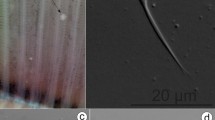Abstract
A survey on prevalence of myxozoan (Myxozoa: Myxosporea: Bivalvulida) parasites was conducted during the 2014–2017 season from two major rivers, Mahananda and Teesta of Jalpaiguri district. 1874 fishes under twenty different genera of eight families were examined, among which 108 (5.76%) fishes of six different genera of four families were found to be infected. The myxozoans were recorded from the gills and tailfins of the host fishes. Intensity of infections fluctuated according to season. Infection rate was lower in monsoon all through the survey period. Maximum infections were recorded in Chanda nama (33%) and Channa punctatus (33%) during summer of 2014–15 and winter of 2014–15, respectively. Six host species were infected with six different myxozoan species. Among the six myxozoan parasites, three have been identified as Myxobolus shantipuri, Myxobolus koli, and Thelohanellus qadrii. Rest of the three species have been identified up to generic level and they are designated as Thelohanellus sp. I, Henneguya sp. I and Henneguya sp. II in this communication.







Similar content being viewed by others
References
Lakhotia AS (2006) Darjeeling warming up faster than world. The Telegraph. https://www.telegraphindia.com/states/west-bengal/darjeeling-warming-up-faster-than-world/cid/760738 Acessed on 13th March 2015
Das A (2017) Comparative study of pollution status of two main rivers: Karola and Tista of Jalpaiguri, West Bengal. India J Chem Pharm Res 9(7):76–81
Dandekar P (2012) Free Flowing and Biodiversity rich Rivers: Most Endangered species in India. SANDRP, Nov.2012:1–9 https://sandrp.files.wordpress.com/2018/03/endangered_riverine_biodiversity_india_nov2012.pdf Accessed on 22nd June 2017
Dey A, Barat S (2015) Evaluation of fish biodiversity in rivers of three districts of eastern Himalayan region for conservation and sustainability. Int J Appl Res 1(9):424–435
Lom J, Vavra J (1963) Mucous envelope of spores of the subphylum Cnidospora (Deflein, 1901). Vestn Cesk Spol Zool 27:4–6
Lalitha Kumari PS (1969) Studies on parasitic protozoa (Myxosporidia) of fresh water fishes of Andhra Pradesh, India. Riv Parasitol 30:153–226
Basu S, Haldar DP (2002) Observations on three new species of Myxobolus Butschli, 1882 from Hybrid carps of West Bengal. India Indian J Environ Ecoplan 6(3):629–640
Kalavati C, Nandi NC (2007) Handbook of Myxosporidean parasites of Indian fishes. Kolkata, ZSI, p 293
Dey VK (1996) Ornamental Fishes and Handbook of Aqua farming. The Marine Products Export Development Authority Cochin. Entrepreneurship Development. Central Institute of Freshwater Aquaculture, Bhubaneshwar, pp 1–6
Talwar PK, Jhingran AG (1991) Inland fishes of India and adjacent countries, vol 1. Oxford & IBH Publishing Co. Pvt. Ltd., New Delhi
Jayaram KC (1999) The freshwater fishes of the Indian region. Narendra Publishing House, New Delhi, India
Margolis L, Esch GW, Holmes JC, Kuris AM, Schad GA (1982) The use of ecological terms in parasitology (Report of an Ad Hoc Committee of the American Society of Parasitologists). J Parasitol 68(1):131–133
Srivastava CB (1980) Estimation of helminthic infections. In: Proceedings of Workshop on Technology of Parasitology, Zoological Survey of India. pp 29–31
Basu S (2002) Studies in some aspects of Myxozoa (Myxosporea: Bivalvulida) in edible fishes of West Bengal. Ph.D Thesis, University of Kalyani, West Bengal.
Fiala I, Bartošová-Sojková P, Whipps CM (2015) Classification and Phylogenetics of Myxozoa. In: Okamura B, Gruhl A, Bartholomew JL (eds) Myxozoan Evolution, Ecology and Development. Springer International Publishing, Cham, pp 85–110
Basu S, Haldar DP (1998) Comparative study on prevalence of Protozoan parasites in pure and hybrid carps. Environ Ecol 16(3):584–587
Basu S, Mitra AK, Haldar DP (2003) Prevalence of trichodinid ciliophoran Ciliophora: Mobilina: Trichodinidae and myxoxoan (Myxozoa: Myxosporea: Bivalvulida) fish parasites in pure and hybrid carps of West Bengal. Environ Ecol 21(Spl.Pub):38–45
Roy R (2018) Gateway of North-East India suffering from severe air pollution. Int J Eng Dev Res 6(1):752–754
Abram QH, Dixon B, Katzenback BA (2017) Review: impacts of low temperature on the teleost immune system. Biol 6(39):11–15
Acknowledgement
First author would like to thank the Department of Zoology of Sidho-Kanho-Birsha University, Purulia for giving permission to do the work. Corresponding author is thankful to DST-FIST [No. SR/FST-LSI/2018/173(c) dated 18/09/2019 for infrastructural support. Authors are also like to express their sincere thanks to the fishermen of the district who generously spent time during the survey and shared their expertise in connection with the local fishes.
Author information
Authors and Affiliations
Corresponding author
Ethics declarations
Conflict of interest
The authors declare that there is no conflict of interest.
Ethical Approval
Not required as per the guidelines of Committee for the Purpose of Control and Supervision of Experiments on Animals (CPCSEA).
Additional information
Publisher's Note
Springer Nature remains neutral with regard to jurisdictional claims in published maps and institutional affiliations.
Significance statement
Myxozoans are responsible for doing considerable harm to the pisciculture. Prevalence study of myxozoans helps to reveal the status of fish health of that particular area which is important both to fish farmers and common people as well.
Rights and permissions
About this article
Cite this article
Banerjee, P., Basu, S. & Modak, B.K. Prevalence of Myxozoan Parasites of Riverine Fishes of Jalpaiguri District, West Bengal, India. Proc. Natl. Acad. Sci., India, Sect. B Biol. Sci. 91, 635–641 (2021). https://doi.org/10.1007/s40011-021-01253-y
Received:
Revised:
Accepted:
Published:
Issue Date:
DOI: https://doi.org/10.1007/s40011-021-01253-y




